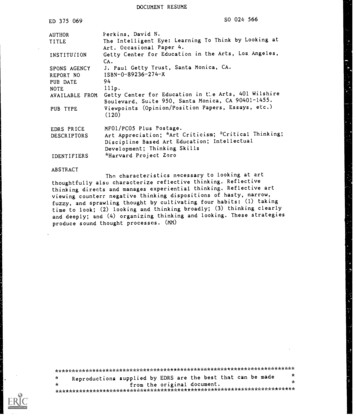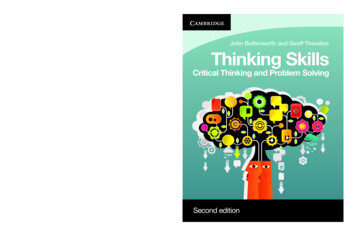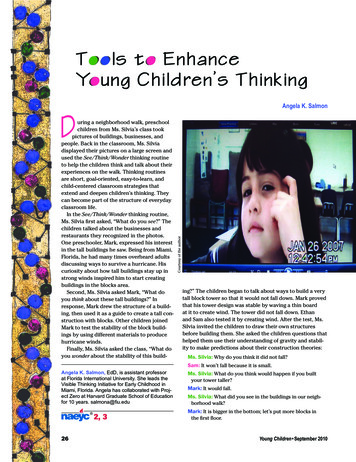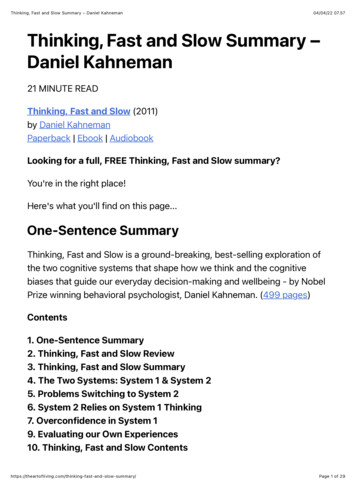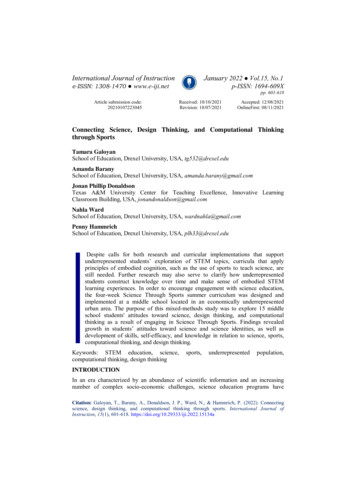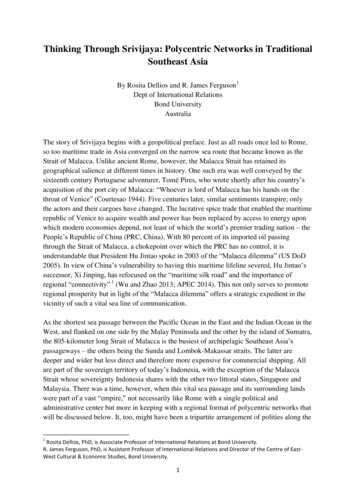
Transcription
Thinking Through Srivijaya: Polycentric Networks in TraditionalSoutheast AsiaBy Rosita Dellios and R. James Ferguson1Dept of International RelationsBond UniversityAustraliaThe story of Srivijaya begins with a geopolitical preface. Just as all roads once led to Rome,so too maritime trade in Asia converged on the narrow sea route that became known as theStrait of Malacca. Unlike ancient Rome, however, the Malacca Strait has retained itsgeographical salience at different times in history. One such era was well conveyed by thesixteenth century Portuguese adventurer, Tomé Pires, who wrote shortly after his country’sacquisition of the port city of Malacca: “Whoever is lord of Malacca has his hands on thethroat of Venice” (Courtesao 1944). Five centuries later, similar sentiments transpire; onlythe actors and their cargoes have changed. The lucrative spice trade that enabled the maritimerepublic of Venice to acquire wealth and power has been replaced by access to energy uponwhich modern economies depend, not least of which the world’s premier trading nation – thePeople’s Republic of China (PRC, China). With 80 percent of its imported oil passingthrough the Strait of Malacca, a chokepoint over which the PRC has no control, it isunderstandable that President Hu Jintao spoke in 2003 of the “Malacca dilemma” (US DoD2005). In view of China’s vulnerability to having this maritime lifeline severed, Hu Jintao’ssuccessor, Xi Jinping, has refocused on the “maritime silk road” and the importance ofregional “connectivity” 1 (Wu and Zhao 2013; APEC 2014). This not only serves to promoteregional prosperity but in light of the “Malacca dilemma” offers a strategic expedient in thevicinity of such a vital sea line of communication.As the shortest sea passage between the Pacific Ocean in the East and the Indian Ocean in theWest, and flanked on one side by the Malay Peninsula and the other by the island of Sumatra,the 805-kilometer long Strait of Malacca is the busiest of archipelagic Southeast Asia’spassageways – the others being the Sunda and Lombok-Makassar straits. The latter aredeeper and wider but less direct and therefore more expensive for commercial shipping. Allare part of the sovereign territory of today’s Indonesia, with the exception of the MalaccaStrait whose sovereignty Indonesia shares with the other two littoral states, Singapore andMalaysia. There was a time, however, when this vital sea passage and its surrounding landswere part of a vast “empire,” not necessarily like Rome with a single political andadministrative center but more in keeping with a regional format of polycentric networks thatwill be discussed below. It, too, might have been a tripartite arrangement of polities along the1Rosita Dellios, PhD, is Associate Professor of International Relations at Bond University.R. James Ferguson, PhD, is Assistant Professor of International Relations and Director of the Centre of EastWest Cultural & Economic Studies, Bond University.1
Malacca Strait, or a wider confederation, presenting itself under a single name for tradepurposes with the Chinese court.Empire, like security, may take many forms. Such an approach allows consideration of anearly manifestation of Southeast Asian regionalism, that of the Sriviyajan “empire” thatemerged in the seventh century and lasted in recognizable form at least until the eleventh. Forthis reason it is important to “think through” the manner in which Srivijaya operated andwhether in doing so the networked past might be able to serve the global present by providingan alternative perspective. To facilitate our task, we turned to two eminent sinologists whoalso dealt with “other voices;” indeed, a leading voice from the Chinese past, that ofConfucius.We adopted the term “thinking through” Srivijaya from the book by David L. Hall and RogerT. Ames, Thinking Through Confucius, which sought to “achieve relative clarity with regardto the principal issues in Confucius’ thought” and “provide an exercise in thinking usingConfucius’ philosophy as medium” (1987, 6, emphasis in the original). Insofar as theconceptual parameters of pre-modern Southeast Asian thought may be deemed as alien topeople today as those of ancient China, then our work is similarly inspired. However,Srivijaya compounds the arduous endeavor of “thinking through” its complexities because itsexistence as a polity is less well documented than China’s and its contours still subject todebate. To think through the Srivijayan “riddle” is to look not only at the archaeological andhistorical evidence or weigh up scholarly theories; it is to take the next step of identifyinginsights that may be congruent with twenty-first century global regionalism. In embarking onsuch a quest, it behoves the academic time-traveller to think, to the extent that it is possible,from the perspective of this archipelagic regional power; one which participated not in theWestern state system with which we are familiar but in a geo-cosmological order derivedfrom Sino-Indic influence. In the end, Hindu-Buddhist ritual and its power, together withChinese rites (of which Confucianism was the major influence) of proper relations, bringthoughts of the world of Confucius and that of Srivijaya into mutual focus. In “thinkingthrough” Srivijaya, it is important to put aside conventional ideas of ethnicity and nationality,state sovereignty and territorial boundaries, as well as international relations and legalconventions. Instead, preoccupations with spiritual power, ritual competence, prestige, royallineage, oaths of loyalty and deterrent curses (see McKinnon 1985) are associated with theSrivijayan era. These coexist with a reputation for cosmopolitism born of trade and anassociated diplomatic awareness of the wider world. Little wonder that in lieu of a “state,”“kingdom” or “empire,” the Indic term “mandala” was reintroduced in some Westernaccounts to describe such political formations – a subject to which we will return. First,however, we will think through what we do not know about Srivijaya, as this predicates muchof what we do know or think we know – based on a small amount of extant evidence.1. Thinking Through what do we do not know about SrivijayaRemarkably, our knowledge of Srivijaya emerged only in the early twentieth century whenthe French scholar Georges Coedès (1918) pieced together evidence of Srivijaya’s existence.2
Others had been working around this idea but had not achieved a breakthrough. A clearproblem was an absence of clues. Certainly the tropical climate and use of perishableconstruction materials were not conducive to the preservation of material culture. Fortunatelyfor posterity, nine inscriptions on stone were found in Sumatra testifying to Srivijaya’sexistence: for example, the Kedukan Bukit Inscription, which was discovered in 1920 in thePalembang area and dated at 683 CE hailed a “Great, prosperous and peaceful Srivijaya” (seeZakharov 2009, 8; De Casparis 1956). It is from these inscriptions, written in the Old Malaylanguage which contained Sanskrit loan-words, that we have the name “Srivijaya.” Sri means“radiant” but is also a royal honorific; vijaya translates as victory or excellence. The presenceof Sanskrit was not unusual in view of the spread of Indian cultural influence in SoutheastAsia early in the Common Era. This was largely due to local rulers adopting the high cultureof Hinduism for prestige rather than any concerted effort on India’s part to colonize theregion (Hall 1984, 68; Wolters 1999:108-111). Military expeditions and conquests in theeleventh century by the South Indian Tamil forces occurred well after the region adoptedHindu-Buddhist culture and were not decisive in its religious leanings.Despite its cultural inheritance, much of what we know about Srivijaya comes not from“mother India” but imperial China with its dedicated record-keeping and with whomSrivijaya had closer political relations. Still, such records by non-Srivijayans do presentanother set of problems. Besides knowledge of Srivijaya being mediated by the experiencesand expectations of external actors – the obvious one is the name by which Srivijaya wasknown to others. Much can potentially be lost in conceptual translation from the name foundin the Old Malay epigraphy of the seventh century to the languages of traders and scribesliving beyond the time and place of the inscribed “Radiant Victory” – Srivijaya. Tangdynasty (618-907) records called this southern source of much valued resins and spices,Shilifoshi. Later, under the Song dynasty (960–1279), Srivijaya was known as the tributebearing kingdom of Sanfoqi, while in Arabic it was often called Sribuza (So 1998, 295;Taylor 2003) or Zabaj when Srivijaya was viewed as a region inclusive of Java (Laffan2005, 67). For Indian traders it was identified with Sumatra and its gold; hence the nameSuvaranadvipa (The Golden Isle). Even in Indonesian, the name Srivijaya is not quite what itused to be: the Sanskrit v has over time indigenized into a Javanese w, becoming Sriwijaya.What was the lifespan of Srivijaya? This depends on how it is conceived and what it is called.According to an authority on Srivijaya, John N. Miksic (2015), Srivijaya was founded a fewyears before 680 CE. It lost its monopoly on trade after having been attacked by Chola (Cola)dynasty forces from southern India in 1025 CE. Thereafter, Miksic notes, the name Srivijayanever appears in any primary source. The most frequently cited endpoint, however, is 1288when Srivijaya was absorbed by its East Javanese rival, Singosari. But as Srivijaya wascommonly referred to by other names, depending on the identity of the external observer,there are further possibilities as to the dates of its demise. Thus one of the Chinese dynastichistories, the Mingshi, reported the decline and disappearance of Sanfoqi in the fourteenthcentury (Sumio 2006, 1). While dynastic histories of China are not a direct or necessarilyaccurate reflection of the political dynamics of other entities, they do present clues. The“san,” for instance, meaning “three” in Sanfoqi suggests that there were Three Vijayas3
(Wolters 1999, 27; Laffan 2005, 18; Suzuki 2014). This would mean that Srivijaya/Sanfoqiwas not necessarily a single entity represented by one royal court but would have comprisedat least three strong centers. Possible candidates for these “champion centers” were theSumatran kingdom of Melayu with its capital at Jambi, Kedah on the Malay Peninsula andChaiya on the eastern side of the Isthmus of Kra (Suzuki 2014), each of which would havetheir attendant dependencies; or perhaps the three were the Sumatran-based centers ofPalembang, Jambi, and Minangkabau (Kozok 2004, citing a fourteenth century documentfrom Sumatra, the Tanjung Tanah Manuscript). While it is still possible to have one kingabove three, and a Khmer one at that – Wolters (1999, 27 citing Barth and Bergaigne 1885,46) gives the example of “a Khmer ruler in the early seventh century” being eulogized as “theglorious sovereign of three kings” – Srivijaya may have been nothing more than “a shiftingriverine zone of entrepôts that could coalesce for mutual interest” (Laffan 2005, 14). It isindeed feasible that the Srivijayan “empire” was a collective unit which would haveexperienced a change in composition and power distribution over the centuries of itsexistence. This means that Srivijaya not only had an uncertain lifespan of between four andseven centuries; but that there was probably more than one Vijaya territorially andtemporally.2. Thinking Through Srivijaya’s mistaken identityThis raises the question of whether Srivijaya’s existence was a case of mistaken identity.What was its actual status in the lexicon of political constructs? Was it an “empire,”confederation or something else? It has even been described as a mix of political formations:a “trade-based city-state empire” comparable to fifteenth-to-seventeenth century Venice(Chase-Dunn et al. 2013). The combination of a small-scale “city-state” with the expanse of“empire,” especially when based on trade, may clarify matters but the thinking through partrequires an understanding of its inner logic. Srivijaya – like other early Southeast Asianruling entities – was a loosely based polity with changes in allegiance a regular feature, andtherefore shifting territorial borders were not unusual. The Chinese pilgrim Yijing (I-ching,635-713), who journeyed to Srivijaya twice (see below), employed the term “guo”(“country”) to describe Srivijaya; it is the same term used for its powerful predecessor (andpossible ancestor in terms of royal lineage) further north on mainland Southeast Asia, theKhmer polity of Funan (100–545 CE). Yet Funan, like Srivijaya, was not a straightforwardcountry/state or “guo” in the Western or Chinese sense. Funan has been shown to be “aconglomerate of chiefdoms but not a state” (Zakharov 2009, 4, citing research by Jacques1979), though this does not discount the possibility of Funan with its centuries of existence(similar to Srivijaya) going through periods of unification and fragmentation. One scholar,Fukami Sumio (2006, 1-2), attests to Srivijaya being a collection of states in the Malaccaregion that stretched from the Malay peninsula across to Sumatra and West Java at the veryleast, before the kingdom of Malacca arose at about 1400.Yet the dominant narrative holds that Srivijaya was a maritime empire or “thalassocracy”(rule by control of the sea) with a single seat of power. This description works up to a point.While relying on maritime trade for its wealth, Srivijaya limited its control to the straits4
within its immediate vicinity, rather than the Indian Ocean or the South China Sea. Thesewere plied by traders from many lands. So Srivijaya could function as a maritime powerwithout having to control the seas, only the straits where it imposed tariffs on commercialshipping, and the hinterlands from which valuable forest products were derived.Thalassocracy as a description also fails to account for the equally compelling rule byspiritual charisma, or what Wolters (1999, 112) called “men of prowess,” an institutionassociated with Hindu kingship even under Buddhist rule; but also manifesting in societiesoutside the Hindu mainstream (Wolters 1999, 113). In reconciling the secular and sacredsources of power, one could say that the sacred aspect of leadership did help in legitimatingsecular goals – control of trade – and shoring up obedience from rival centers.Those who view Srivijaya as a single kingdom (even if only in the initial phase) tend to agreethat it maintained its headquarters in Palembang on the Musi River in southeastern Sumatra.It is in this vicinity that most of the stone inscriptions were found, as well as otherarchaeological remains. Besides its reputation at the time as a place of power in Tantric ritual,reasons posited for selection of the lower Musi River for establishing the Srivijayan capitalinclude the river’s rich alluvial plain for the cultivation of surplus rice; its navigability,allowing access to forest products inland as well as the natural harbour some 80 kilometersdownstream (Hall 2011, 113, 116; Junker 2006, 220). Such a distance would not have beenconsidered an imposition but was the norm along the east Sumatran coast where the tidalswamplands affected the location of seaports. As Miksic (2011) notes, ports could be morethan 100 kilometers from estuaries. Bearing this in mind, other port-settlements would havealso proved serviceable for the role of capital. Notable among these is Jambi, north ofPalembang, and located 120 kilometers up Sumatra’s longest river, the Batanghari,representing a better location for accessing gold from the highlands of Minangkabau. Indeed,if there was life for Srivijaya after the 1025 Chola attack, then it was to be found at Jambi,conventionally regarded as Srivijaya’s new capital and which could have been the Srivijayanroyalty’s point of origin rather than the more distant Funan in the Khmer region. Whatoccasioned the shift to Jambi in 1079? Various theories have been put forward. These includePalembang’s vulnerability to attack and Jambi’s proximity to sources of gold in a moreaccessible hinterland (Lieberman 2009, 775). Silting of the Musi River to the point ofblocking access to the sea is another reason posited for the decline of Palembang (Gipouloux2011, 61). Considering its choice of ports along the Malacca Strait, with many being onlyabout 10 kilometers up river (Miksic 2011), there was indeed a noticeable clinging to thePalambang-Jambi axis, around which a vast “empire” pivoted; moreover it served as theMalacca Strait’s southern gate to the China trade. It was a gate which swung both ways,allowing China secure access to all that the Malacca region represented – trade with India andbeyond, as well as a strategic outlet to compensate for periodic overland trade difficulties, asoccurred during the Tang dynasty. Thus, China needed a reliable power to police the Strait.At its peak in the ninth century Srivijaya exercised suzerainty over areas in Sumatra, westernJava, possibly western Kalimantan, and certainly the Malay Peninsula right up to the Isthmusof Kra. Srivijayan rulers tried to curtail portage of seaborn trade across this narrow landbridge in order to divert all trade to their own ports which, after all, were the primary source5
of their wealth. As a trans-shipment zone, the Malacca area was a “strategic place whereships were forced to congregate,” according to a Chinese source of the time, the Treatise onForeign Lands (Zhufanzhi, c. 1225 in Sumio 2006, 3). Indeed, there is a general consensus,that at its height, Sriwijaya was “one of the major emporia of Asia, through which regionalproduce reached the markets of western Asia, India, and China” (Wolters 1999, 32).Srivijaya – to continue in the vein of its singular identity – treated trade as an expression ofits power as well as a secular source of it. This meant that it was better to monopolize than tocompete and to trade through authorized government channels (“tribute-trade”) rather than anopen market. Though not always possible, it remained the preferred position, and a widerregional norm as demonstrated by China’s own “tribute-trade” system. The result wascenturies of (sometimes enforced) stability. This was because each dominant center (or aconfederation), with the allegiance of secondary and tertiary centers, was the overlord of itsdomain. Thus Srivijaya’s was the archipelago; China’s tributaries included Srivijaya – andtherefore its dependencies – within the Chinese sphere. Taylor (2003, 24) notes that:Chinese records show tribute missions (trade) in the sixth, seventh, and eighth centuries andagain in the tenth and eleventh. Srivijaya’s “tribute” consisted of pepper, resins, rattans, ivory,plumes, birds’ nests, turtles, sea cucumber, and mother-of-pearl; “gifts” from China’semperors to Srivijaya were industrial dyes, iron, ceramics, and silk. In the Chinesepresentation, for seven hundred years a Sumatran state is recognized as a vassal, which actsas intermediary for many barbarian archipelago harbor states, bringing their tribute to Chinaalong with Srivijaya’s own. In Chinese presentation, the honor of being a vassal is conferredby China, and it is taken away by China when the vassal proves itself unworthy. In 1380,Srivijaya was stripped of its special relationship to China and the honor of being China’svassal was transferred to the Javanese kingdom of Majapahit.Srivijaya was not only a vast maritime power, but can also be considered the first of its kindin island Southeast Asia. This is despite the existence of a central Javanese rival for control ofthe straits: the Sailendra dynasty (750–850), the details of which are as difficult to ascertainas those of Sriviyaya. Inscriptions and other evidence suggest the Sailendras asserted theirinfluence on both island and mainland Southeast Asia for a time, but their
which modern economies depend, not least of which the world’s premier trading nation – the . 1 Rosita Dellios, PhD, is Associate Professor of International Relations at Bond University. R. James Ferguson, PhD, is Assistant Professor of In





